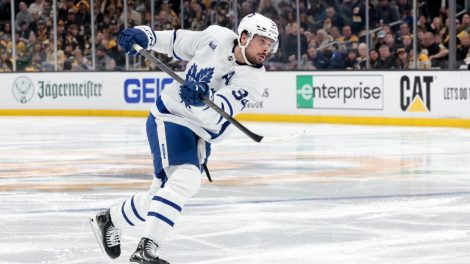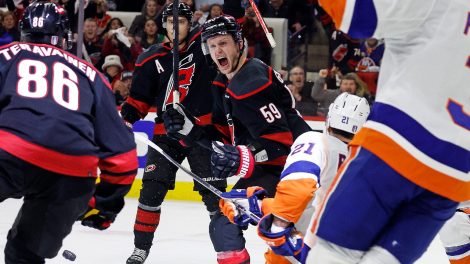During my career as a hockey writer I’ve spent a lot of hours loitering outside conference rooms in a nice hotel.
And virtually every time I was dispatched to cover a meeting of NHL general managers, board of governors or the competition committee, I had trouble shaking the nagging feeling that a lot more was going on behind closed doors than we’d ever be told about.
Of course there was.
Now the curtains have been pulled back somewhat with the minutes from a few of those meetings appearing among the 297 documents recently unsealed in the concussion lawsuit brought forth by former NHL players.
They offer a window into how the league operates at its highest levels and include discussion points and ideas that might otherwise have never seen the light of day. Here’s a look at a few of the things that stood out:
—–
At a meeting of the competition committee in June 2007, commissioner Gary Bettman proposed that all players be required to remove their helmets while taking shootouts or penalty shots.
He indicated to representatives of the NHL Players’ Association that “the idea would not work unless it was mandatory and that the league is strongly in favour of the idea,” according to the meeting minutes. The NHL’s entertainment people believed “it would really add to the moment.”
Stu Grimson, then employed by the NHLPA, said that a recent player survey showed the membership wasn’t in favour of that change and added that the rationale for it would need to be explained further before they voted on it.
Bettman stated that it was up to the NHLPA to make it happen. It never did.
—–
Discussions about using bigger nets have happened a couple times over the years, with Philadelphia Flyers owner Ed Snider advocating for them as far back as the competition committee meeting in July 2005.
Testing for some of the dramatic rule changes brought in during the lost lockout season had already been conducted in the American Hockey League, and Snider wasn’t convinced they would be enough to meaningfully increase scoring.
He pointed out that players had increased in size over the years without the proportions of the goal they were shooting on being touched.
“Mr. Snider does not feel that the reduction in equipment alone will make a big difference,” according to meeting minutes. “Does not think that changing the size of the nets is as radical as the change we are already pursuing.”
His proposal was voted down 9-1, with Predators GM David Poile adding the caveat that he had “a lot of interest the longer you talk about it. … Leave it on the table going forward.”
There it remains.
—–
Three-point games were described as a “contentious issue” in minutes from that competition committee gathering in July 2005.
The league and owners wanted the system we have in place today – with a point awarded to any team that loses in overtime or a shootout in addition to the two that go to the winner. But the players didn’t like that idea: “They don’t think a point should be awarded for mediocrity. They felt there should be a winner and there should be a loser.”
Ultimately, it was mentioned that GMs didn’t want the playoff races to end on Feb. 1.
Parity won the day.
—–
When the NHL was preparing for the last round of realignment, which was brought in for the 2013-14 season, Bettman told GMs during their November 2011 meeting that he welcomed input from them on the subject.
The commissioner added that Columbus, Minnesota, Detroit and Dallas had all asked for a change, with Winnipeg promised a spot in the Western Conference.
They were all moved as part of the divisional shakeups that occurred.
—–
The single biggest issue standing in the way of altering the NHL’s current 200-by-85-foot ice surface is building logistics. In fact, at the 2011 GMs meeting, ice guru Dan Craig said that only two arenas were capable of being expanded – and they would require “extensive and expensive renovations.”
At that point Craig estimated it would only cost about $100,000 to build a rink capable of expanding if done at the design stage.
Brian Burke, then GM of the Toronto Maple Leafs, said it would take 30 years for all of the NHL buildings to be replaced and proposed that each new one be built with the ability to convert because “the game already needed more space.”
Oilers GM Steve Tambellini agreed, and Islanders GM Garth Snow said it was something his organization was already cognizant of.
However, nothing formal was ever passed and that suggestion appears to have fallen by the wayside. Word is that Edmonton’s Rogers Place, which is due to be opened in the fall, isn’t being constructed in a manner that allows the ice to be converted to a hybrid surface.
—–
Jeff Halpern, then a member of the Tampa Bay Lightning, attempted to get the plus/minus statistic eliminated during a competition committee meeting held in June 2009.
Coming off a season where he finished minus-13, Halpern called the stat “arbitrary and problematic” – a view still held by many in the game – and argued that it “encouraged minus players to hang back and play scared and discouraged them from taking chances offensively,” according to the minutes of the meeting. He added that it didn’t provide an accurate reflection of an individual’s play.
At minimum, he asked for the league to stop awarding a minus in instances where a player was on the ice for an empty-net goal against. However, he wanted a plus given to those out when their team scored into an empty net.
Predators GM David Poile agreed the stat had a negative impact on the psyche of players and then-Devils GM Lou Lamoriello asked if it could be removed from the NHL’s stats package. Bettman responded that he would have to check with the PR department, but concluded that it was an issue on the league’s radar.
The plus/minus statistic is still used today.
—–
Any hockey parent knows that sticks can be expensive. NHL teams feel that pain, too.
Hockey operations vice-president Kris King surveyed the budgets of 10 unidentified teams before the November 2011 GMs meeting and found that they were projecting to spend between $270,306 and $531,822 on sticks that season.
“(King) noted that stick manufacturers often charge varying amounts to different teams for the same stick types and quantities,” according to the minutes.
—–
During a GMs meeting at the 2010 Stanley Cup final in Philadelphia, Bettman confirmed that Carolina and Phoenix would play exhibition games against KHL teams before the 2010-11 season.
This was at a fairly frosty period in NHL-KHL relations, but the commissioner indicated the payoff was too good to refuse: “Commissioner Bettman advised that the league had been offered a significant amount of money to participate in these games, and stated that while it was a difficult decision to make, on balance he thought that it made sense to play these games at this time,” according to the minutes.
The Hurricanes wound up losing 5-3 to SKA St. Petersburg the following September in a heated game that saw some questionable hits thrown. It got so bad that Carolina held captain Eric Staal out of the third period as a precaution.
“It seemed like they were getting closer and closer to his knees and there wasn’t a big concern on the ice about it,” then-Hurricanes coach Paul Maurice told NHL.com. “He’s a National Hockey League star player and he should be playing in the National Hockey League.”
Exhibition games between NHL and KHL teams haven’t been held since.









